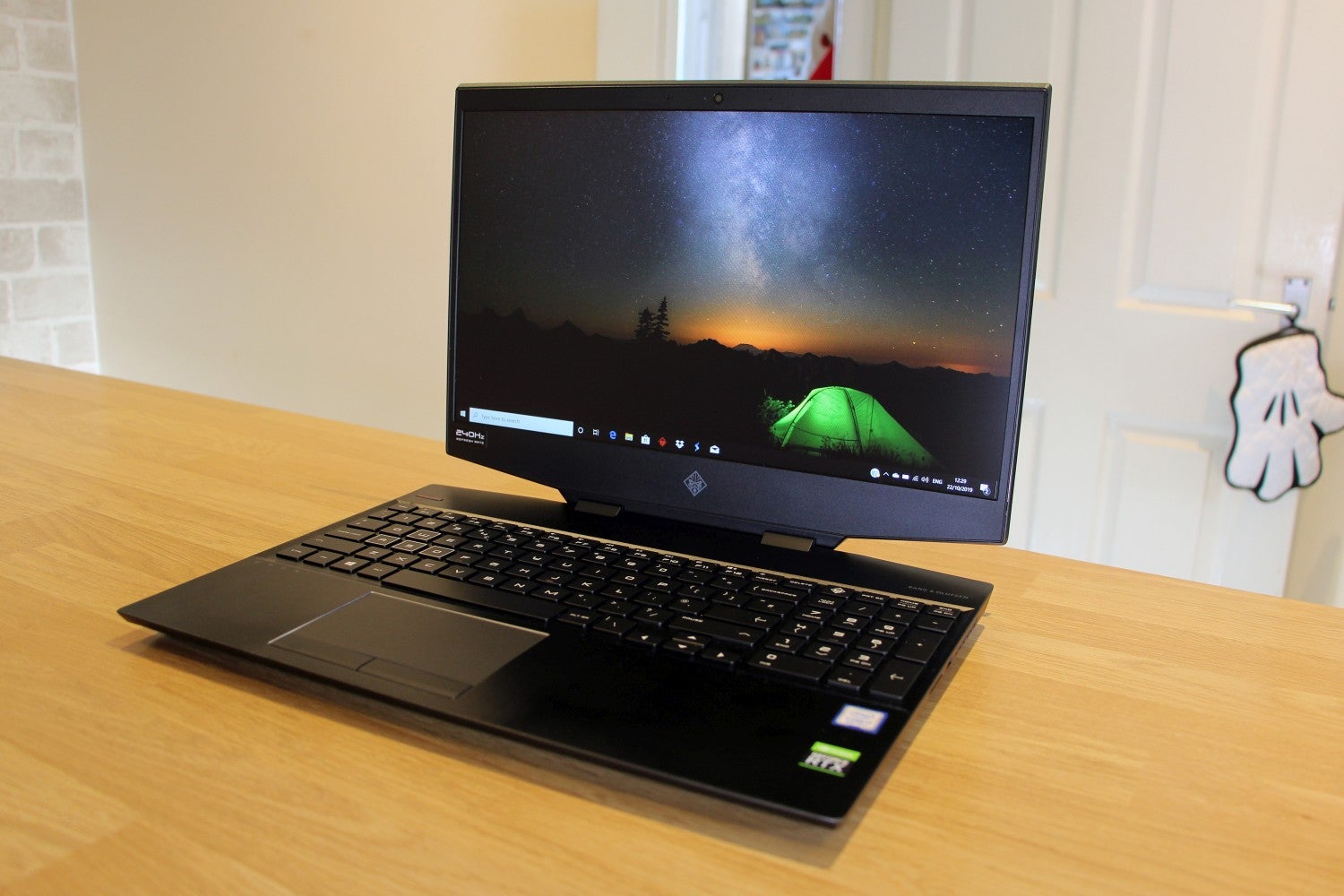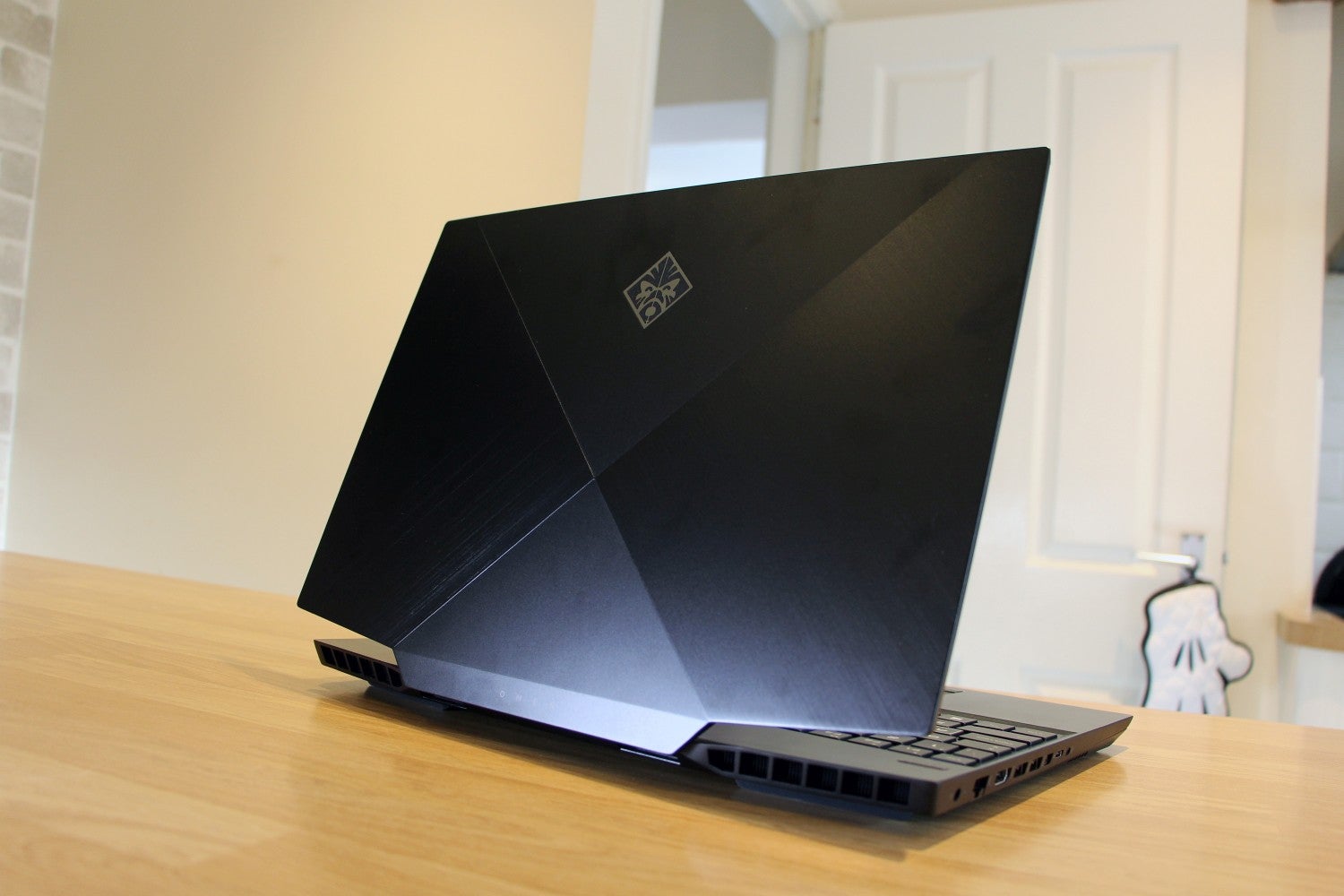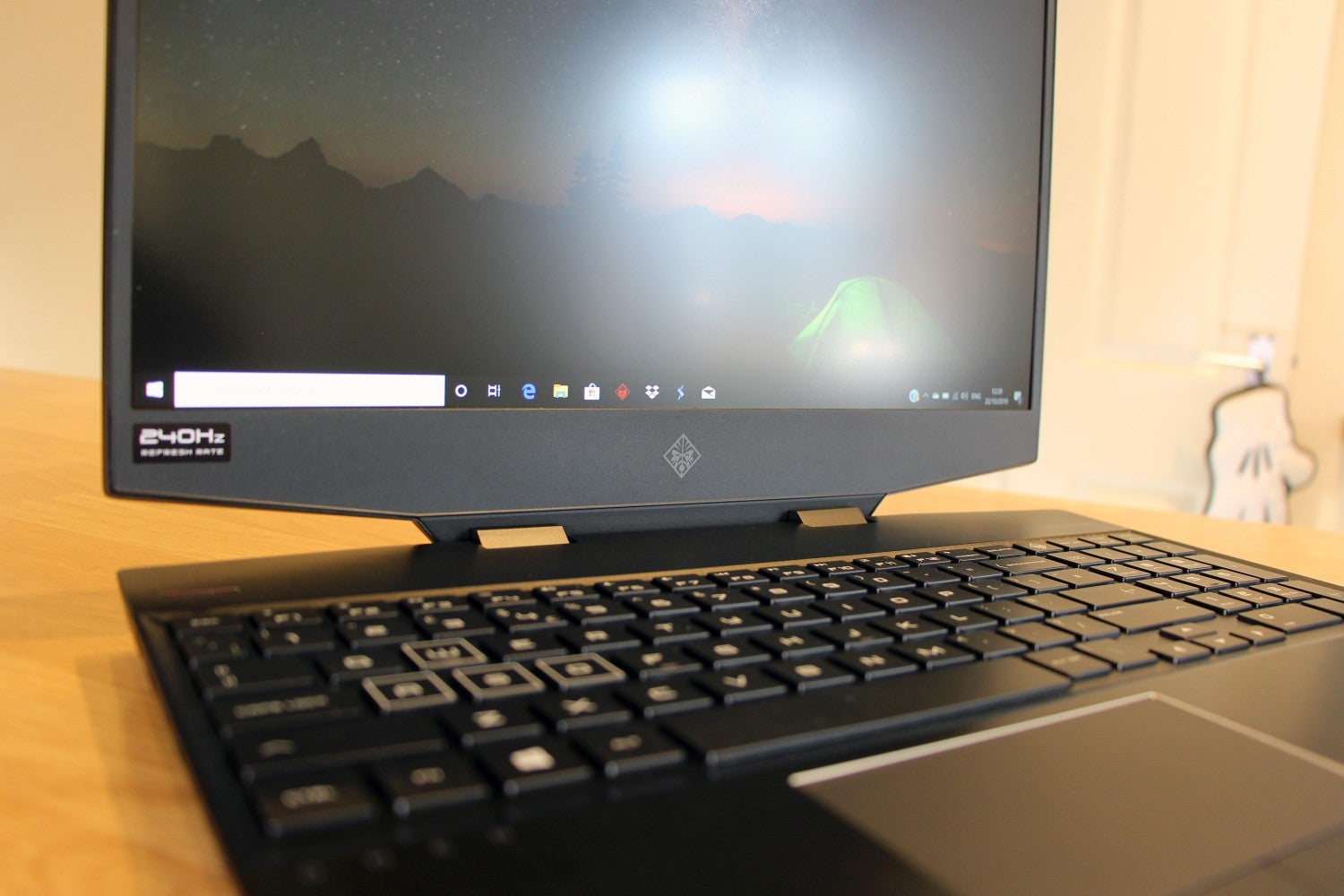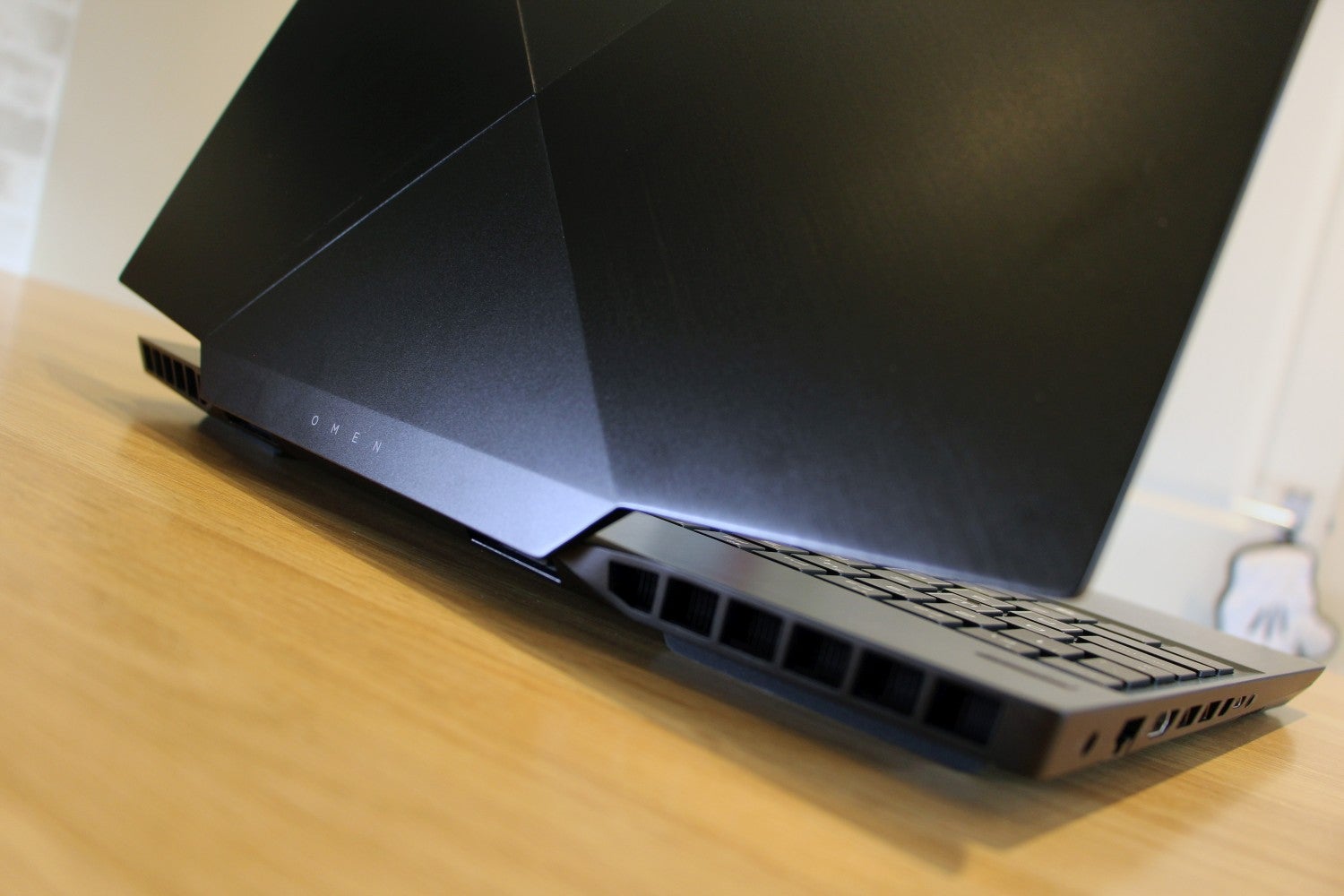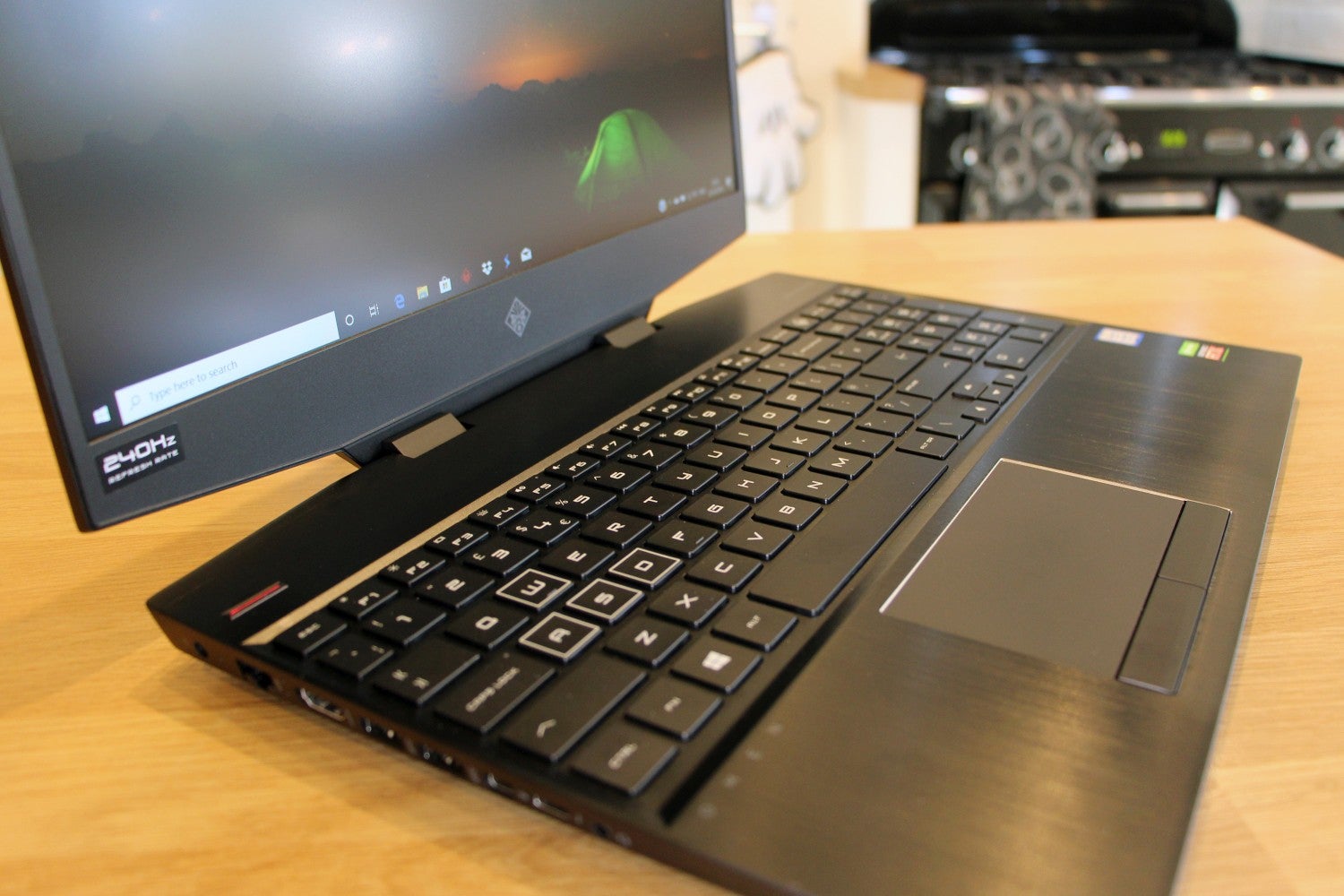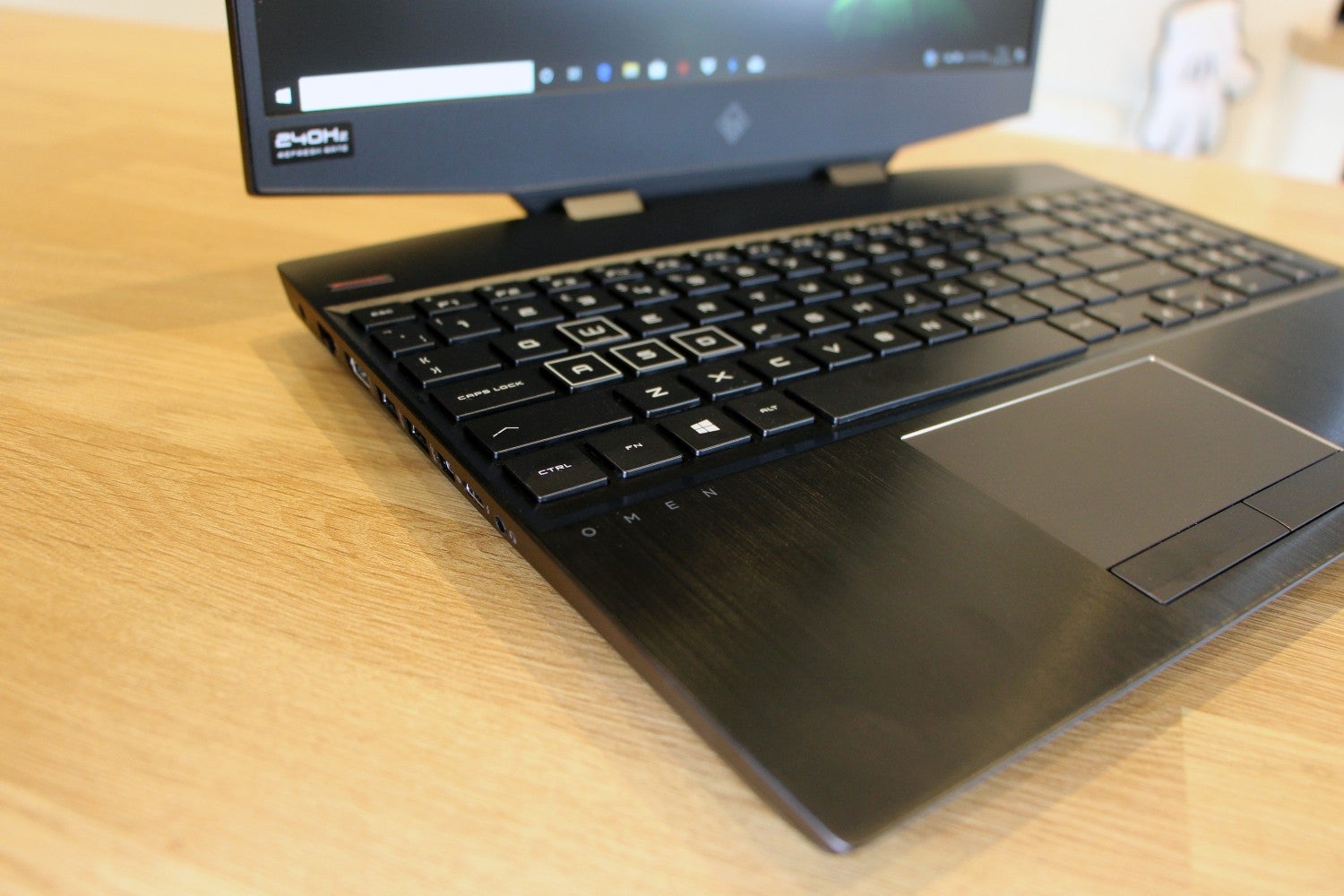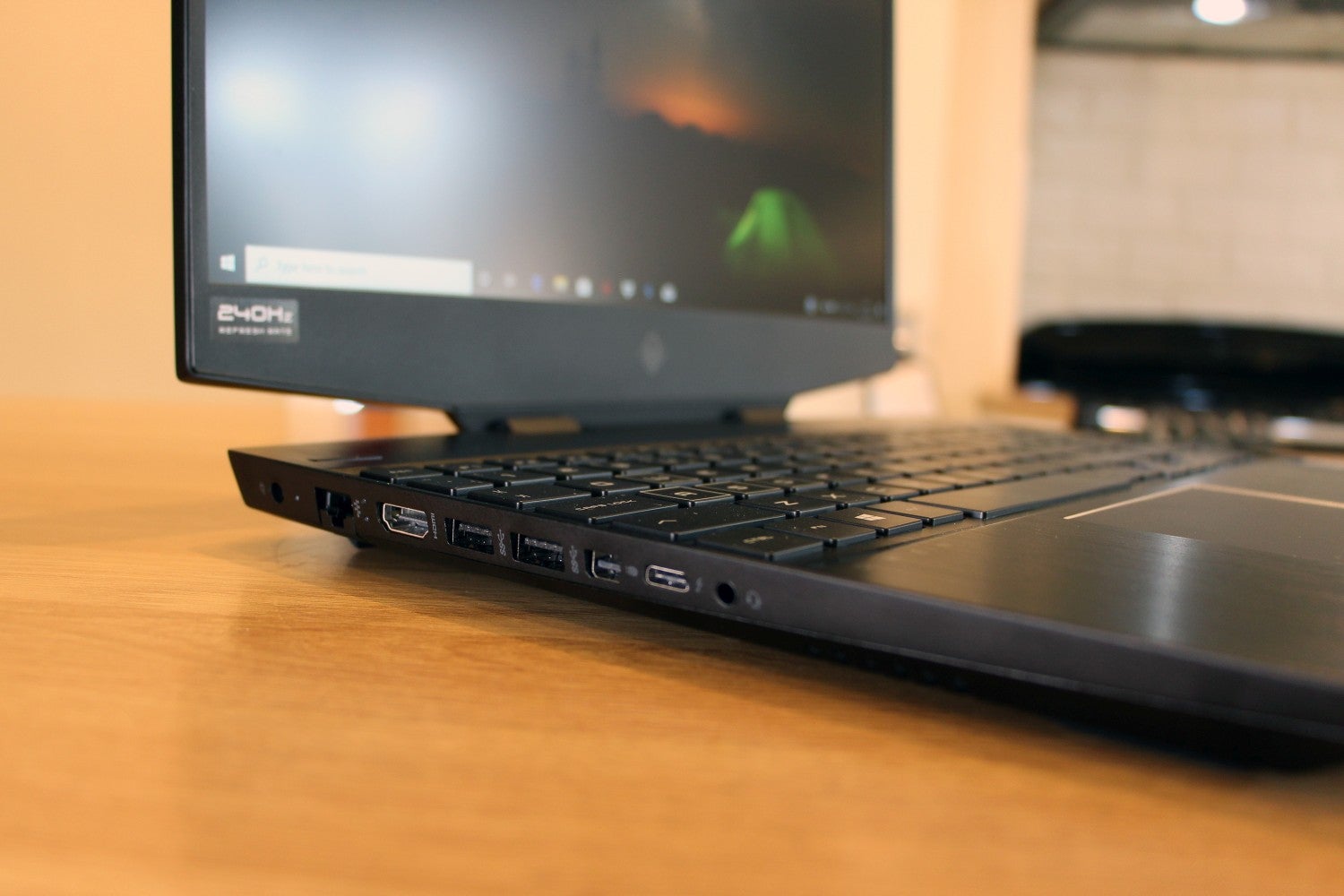HP Omen 15 (2019) Review
HP Omen 15 (2019) Review
The HP Omen 15 crams in a 240Hz G-Sync screen, an RTX 2070 graphics core and a Core i7 CPU
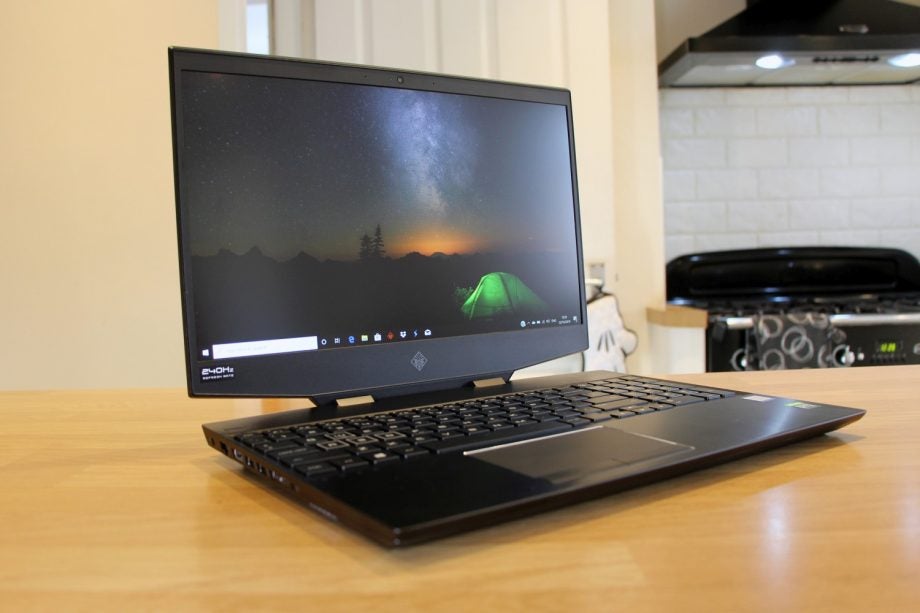
Verdict
Fast, attractive and full of great features – you won't find much to complain about with the HP Omen 15, one of 2019's best gaming laptops
Pros
- Superb 240Hz G-Sync screen
- Fast, well-balanced specification
- Robust, smart exterior design
- More affordable than key rivals
Cons
- Razer Blade 15 is faster in games
- Could be slimmer and lighter
- Underwhelming battery life
- Middling speakers and trackpad
Key Specifications
- Review Price: £1699
- 2.6GHz Intel Core i7-9750H
- Nvidia RTX 2070 8GB Max-Q
- 15.6in 1920 x 1080 240Hz IPS Nvidia G-Sync screen
- 16GB 2666MHz DDR4 memory
- 1TB NVMe SSD
- Windows 10 Home 64-bit
- 1yr RTB warranty
What is the HP Omen 15?
The HP Omen 15 is a refresh of the big-brand laptop, with HP making changes both inside and out.
This new Omen includes Nvidia Turing graphics and one of Intel’s latest processors – so, on the face of it, has the power to succeed. Arguably, those aren’t the most exciting feature, either: this machine also includes a screen with a whopping 240Hz refresh rate.
You’ll have to spend £1699 or $2209 to buy this laptop – in the UK, opt for model number 15-DH0007NA; in the US, head to HP’s website to configure this specification. Let’s find out if HP’s updated Omen 15 is worth such the significant outlay.
HP Omen 15 design – A brooding design with a robust build
Still recognisably an Omen machine, there are familiar design touches throughout. However, HP has toned down this laptop compared with previous generations.
The dramatic Omen logos remain, for instance, but this time they don’t light up. In addition, the red accents that featured on previous machines have been dialled back – the only crimson flourish you’ll see now is on the power button.
The machine is darker and more brooding than previous efforts. The lid is hewn from black metal, divided into sections sporting different textures. Brushed metal continues to the wrist-rest, and there are no odd angles or extra ornamentation to be found on the base of this machine – it’s all dark metal and all business.
Nevertheless, the Omen 15 remains more outlandish than the rival Razer Blade 15. The latter sported a more restrained design, looking more like a MacBook than a gaming laptop.
Weighing in at 2.5kg, with a thickness of 20mm, the HP Omen 15 is chunkier and heavier than the Razer, too – that laptop sits at 2kg and 17.8mm. If you want something slimmer and lighter, the Blade 15 wins.
It’s good to know those chunky dimensions are paired with good build quality. The metal surrounding the base suffers barely any give, and the rear of the screen is robust. The only slight issue is that the Omen’s central hinges result in the sides of the screen feeling a little weak.
We’d advise you carry the Omen in a protective sleeve to avoid scuffs or scratches, but there’s little doubt this laptop is strong enough to survive life on the road.
When it comes to connectivity, the HP Omen 15 delivers: it has three full-size USB 3.1 ports and a Type-C connector with Thunderbolt 3 support. There’s also Gigabit Ethernet, HDMI and mini-DisplayPort outputs, plus an SD card reader.
There’s plenty on the inside, too: future-proofed 802.11ax Wi-Fi 6, Gigabit Ethernet and Bluetooth 5.0. That’s better than most gaming laptops, and it matches the Razer.
Related: Best Gaming Laptops 2019
HP Omen 15 display – A superb panel that will do the job for gaming
The screen’s specification is superb. The 1920 x 1080 resolution is ideal for gaming, and the Omen includes Nvidia G-Sync that peaks at 240Hz.
The Razer Blade also has a 1080p screen with a 240Hz refresh rate, but it lacks G-Sync. So, while both laptops will deliver smooth gaming at high speeds, HP’s inclusion of G-Sync makes it a winner here.
Of course, having a 240Hz screen just won’t be necessary for all folk. If you play high-end single-player games then you’re unlikely to get close to 200fps, so the refresh rate is redundant.
Competitive eSports players will benefit from games running smoothly at that speed – because every advantage is important – and such games will run happily at those frame rates. However, only serious players will see a significant advantage here, so it’s worth weighing up your priorities –a more modest 144Hz screen would be a smart way of continuing to gain smooth performance whilst saving cash.
Screen quality is great. The measured brightness sits at 323 nits – easily high enough for indoor and outdoor gaming. Blacks come in at 0.27 nits, which is reasonable, and the resulting contrast ratio of 1196:1 is solid. It’s good enough to deliver plenty of punch and vibrancy in all games.
That contrast ratio figure compares well next to the Razer, although the Blade did deliver a better brightness level. On balance, we prefer the Omen – it’s bright enough, and the better contrast delivers greater depth.
The Omen dispatched a Delta E measurement of 1.88, meaning the colours are sufficiently accurate that human eyes can’t detect deviations. The temperature of 7112K is fine, albeit a little chilly, and enough to give brighter areas a tiny blue pall – but not too far removed from the Razer.
HP’s laptop rendered 93.3% of the sRGB colour gamut. That’s easily good enough for gaming, and a little better than the Razer.
Overall, the Omen 15’s screen is superb. The inclusion of G-Sync makes it smoother than Razer’s panel, the 240Hz refresh rate is brilliant for eSports and future-proofing, and the HP consistently produced better benchmark results.
This fantastic screen is paired with a reasonable set of speakers. There’s plenty of clarity and punch in the middle of the range, so gaming will be acceptable with this audio kit. Bass is weak and the top-end is slightly tinny, though, so a headset would still be a sound investment.
Related: Best Gaming Headsets 2019
HP Omen 15 keyboard and trackpad – Great for casual gaming and eSports alike
HP’s keyboard has a customisable RGB LED backlight, it supports 26-key anti-ghosting – making it more practical for gaming – and has a numberpad, too.
The Omen’s chiclet keyboard offers decent quality for a gaming laptop. The buttons display 1.5mm of travel, which is just enough, and the base is firm so you’ll be able to hammer down on buttons with confidence.
Good enough for mainstream and casual gaming, plus eSports thanks to its solid speeds, the keyboard offers robust design and reasonable travel. You’ll experience greater travel and speed with more conventional units, though, so serious players may still want to search out a machine without chiclet hardware.
HP’s keyboard is better than the Razer’s typing unit. Its shallow keys didn’t deliver sufficient travel or feedback.
The surface of the Omen’s trackpad is fine – it’s large and responsive – but the two buttons are soft and push down too far. This isn’t a disaster, but anyone who wants to enjoy gaming would do well to use a mouse.
Related: Best Gaming Mice 2019
HP Omen 15 gaming performance – Fast and smooth, although can’t quite keep up with main rival
HP deploys the Nvidia GeForce RTX 2070 Max-Q in this laptop. It retains the 2304 stream processors, 36 ray-tracing cores and 8GB of memory of the full-fat RTX 2070, but its boost clock sits at 1,185MHz – 255MHz behind the full-power mobile GPU.
Nevertheless, the GPU is powerful. It rattled through Shadow of the Tomb Raider with an average of 80fps, just three frames behind the Razer Blade 15. In Dirt Rally its average of 109fps was a frame better than the Razer, and in the tough Ghost Recon: Wildlands it ran at 46fps – six frames back from the Razer.
In 3DMark: Fire Strike the HP scored 13,194, which again puts it behind the Razer – that laptop scored 15,365.
Overall then, the HP is fast, albeit slower than the Razer. In real-world terms, these scores mean the HP can handle any single-player game at fast, smooth speeds for at least the next few years. It will also play ray-traced titles without issue: in Battlefield 5, with the setting activated, the HP averaged 62fps.
The RTX 2070 Max-Q will handle outputting to 1440p screens and some widescreen panels, too. If you’re an eSports player, this GPU can handle the top competitive games at beyond 200fps – so they’ll look smooth on the 240Hz screen.
However, the cut-back RTX 2070 won’t handle everything. It isn’t fast enough to play single-player games at beyond 200fps, unless they’re older titles or have graphics settings cut back. If this means you won’t be using the panel to its full extent, a cheaper 144Hz model migh make more sense. Don’t expect the RTX 2070 Max-Q to comfortably output to 4K screens or high-end VR headsets, either.
If you do need greater power, the HP Omen 15 with an RTX 2080 costs £2000 in the UK and $2360 in the US.
If you don’t need the RTX 2070’s power, an Omen with an RTX 2060 is available for £1450 or $1860, and a GTX 1660 Ti version costs £1350 or $1730. Both models are still available with the 240Hz screen and are more affordable options for eSports.
These prices compare well to Razer’s machines. Blade models are available with all of these GPU options, too, but they’re always more expensive; plus you have to pay extra for 240Hz screens.
It’s also possible to buy the HP Omen X 15, which adds a second screen, better CPUs and extra memory. However, RTX 2070 and RTX 2080 versions cost £2500/$3000 and £3500/$3400 respectively, so they’re not cheap.
Related: The Best Gaming CPUs
HP Omen 15 application performance – Plenty of oomph for day to day tasks
The Omen uses a Core i7-9750H processor, which is Intel’s most popular high-end mobile chip. It has six cores and speeds of 2.6GHz and 4.5GHz, but no Hyper-Threading.
Those figures mean you won’t suffer gaming bottlenecks, with speed and core count ensuring that day-to-day web browsing and Office applications, alongside photo-editing and light video work, won’t prove a problem. The Razer uses the same chip, and it’s no surprise it’s popular.
In Geekbench’s single- and multi-core tests, the HP scored 5239 and 20,999 points. That’s superb – and on both counts better than the Razer’s performance, because that slimmer, lighter laptop suffers more issues with throttling.
The Omen took a lead in PCMark 10, too, where its result of 5958 was nearly 1000 points better than the Razer Blade.
Both the HP and Razer machines will handle gaming and day-to-day computing without significant slowdown, but the Omen has more oomph; it will be a bit quicker in tougher tasks.
The Omen is bolstered by 16GB of memory and a strong SSD. Its read and write speeds of 2699MB/s and 2118MB/s aren’t the best, but they’re still fast. They’re quick enough to keep the HP feeling snappy. Its 1TB capacity is huge too, although there’s no hard disk.
Thermal performance is occasionally inconsistent. It performs well while gaming: the GPU peaked at a temperature of 71ºC, and the exterior remained cool. Noise levels are decent, too – fan noise is present during gaming, but speakers or a headset will easily mask it. Plus, it’s much quieter than the Razer.
Running the processor at 100% load saw the CPU’s temperature rise to 98ºC and its speed throttle to around 2.4GHz. The Blade was poorer in this regard. You’re unlikely to experience such issues during everyday workloads where CPU load varies, but it does mean you won’t get the full ability of the HP’s CPU if you constantly push it at a high level.
Not surprisingly, battery life is poor. In a low-end application test the HP lasted for 2hrs 52mins. That’s just over an hour behind the Razer.
In a gaming test the Omen lasted for just over an hour, which is virtually the same result as the Razer. While Razer’s machine lasts slightly longer in applications, then, neither system will make it to lunchtime – and neither will handle a good gaming session without being plugged in.
Related: Best Antivirus 2019
Should I buy the HP Omen 15?
The HP Omen 15 is an impressive gaming machine. The RTX 2070 Max-Q will play single-player games at good speeds and eSports titles at beyond 200fps. The rest of the specification is great, and the screen is stellar – quality levels are high and the inclusion of 240Hz G-Sync means nothing is as smooth as the Omen’s panel.
Connectivity is excellent, too, and the Omen even has a reasonable keyboard; it looks the part and build quality is good. As ever, this gaming notebook isn’t perfect. It could be slimmer and lighter, and battery life is poor. Razer’s more expensive machine offers a little more gaming power too.
There’s also the question of that 240Hz screen: it’s incredibly smooth right now and is future-proofed, too, but single-player games won’t achieve these speeds and it does add cost. Many could save money by opting for a 144Hz panel instead.
Whether or not you need that 240Hz screen, though, the HP Omen 15 is a superb gaming machine. It’s consistently fast, ergonomically sound and has a robust, smart exterior design along with a stunning screen – and it’s cheaper than its key rival. It’s one of the best options right now when it comes to powerful, versatile gaming laptops, and well worth a recommendation.
How we test laptops
Unlike other sites, we test every laptop we review thoroughly over an extended period of time. We use industry standard tests to compare features properly. We’ll always tell you what we find. We never, ever, accept money to review a product.


